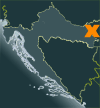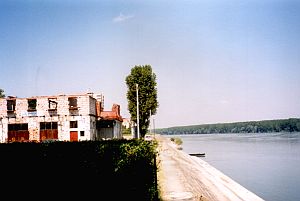|
|
|
 Name:
Vukovar. The name of the town derives from the small river Vuka, a small tributary flowing into the Danube in Vukovar.
The name Vuka again might derive from Vucedol - a tribe settling in East Slavonia during the Bronze age.
Centuries ago, there was a fortress called Vukovo. Another out-of-use name is Wolkovar.
Name:
Vukovar. The name of the town derives from the small river Vuka, a small tributary flowing into the Danube in Vukovar.
The name Vuka again might derive from Vucedol - a tribe settling in East Slavonia during the Bronze age.
Centuries ago, there was a fortress called Vukovo. Another out-of-use name is Wolkovar.
Location:
Vukovar stretches along the right (western) bank of the river Danube. The Danube marks the border to →Serbia.
The area around Vukovar is called East Slavonia / Syrmia. Except for some marshland, it's a very fertile plain without any hills. The capital
→Zagreb is around 225 km away - as the crow flies - to the west. Vukovar is Croatia's easternmost city so to say.
Almost in the heart of the town, the small river Vuka flows into the Danube. The closest bigger city is →Osijek - the centre of
East Slavonia - 20 km west of Vukovar.
Population:
Some 30,000 (2001). One third of the citizens are Serbs, which still causes problem. More than 50 % are Croats, the rest
other minorities.

| |
Vukovar at the Danube - and Serbia on the right
|
Beware: Large parts of the city underwent heavy mortar
attacks during the war, destroying virtually every building. To rebuilt the entire city will take a lot of time. Hence,
common sense regarding mines and UXO's (unexploded ordinances) is absolutely necessary.
History:
Naturally, the history of Vukovar is quite similar to the history of nearby →Osijek.
The Romans built first settlements and castles along the river Danube to protect their empire. During the 10th century, a
small fortress called Vukovo was founded in present-day Vukovar. However, the name 'Vukovar' didn't
appear before the 14th century. As with the rest of Croatia (see also →History of Croatia),
Vukovar was occupied by the Ottoman empire for many centuries. In 1687, the Austrian Habsburg monarchy gained control over the
area, letting Serbs and Croats settle along the Danube. After 1918, Vukovar became part of Croatia resp. Yugoslavia.
After Croatia declared independence, mounting tensions between radicalized Croats and Serbs in and around Vukovar
developed into a full-scale war. According to various sources, it all started with a Serb dominated village refusing to hoist the Croatian
national flag. Croatian authorities decided to send in a police squad, but it turned out to be an ambush. Some police officers were killed.
According to other sources, already before this incident ethnic cleansing by the Croats had taken place around East Slavonia.
Needless to say that declarations regarding the beginning of war are contradictory. But it's a fact that
this incident marked the beginning of war. Soon, Vukovar's citizens found themselves besieged by the Serb-dominated JNA (Yugoslav National Army).
The siege included daily heavy mortar shelling.An estimated 2,000 people found shelter in a hospital for three months. After that, the JNA
managed to capture the town. According to the War Crime Tribunal in Den Haag, many civilians were massacred after the capture.
Vukovar remained under Serbian control until 1995, before the UN administration took over. Following a mutual agreement, Vukovar was
handed back to Croatia in 1998, but it's still under international observation to protect the Serb minority.
Comparable to →Mostar, Vukovar is a united town divided by an invisible frontier, which is
defined by ethnicity. The frontier might be invisible, but it doesn't look like it's going to vanish in the near future.
Getting there:
There's a railway connection, but there are no long-distance trains stopping in Vukovar. The best way to go is via
→Osijek, which is only about 25 km away. Several buses a day run between Vukovar and Osijek. It takes less than
one hour, the return fare is 37 Kuna. There are even direct buses from Germany to Vukovar. There's no border crossing with
→Serbia in the vicinity, so it's necessary to go to the north or to the south first.
|